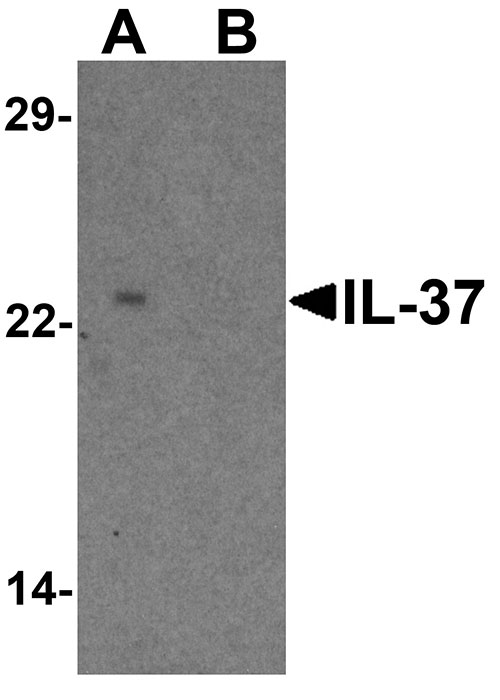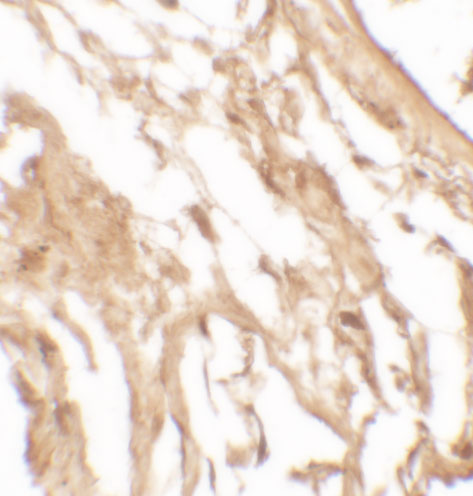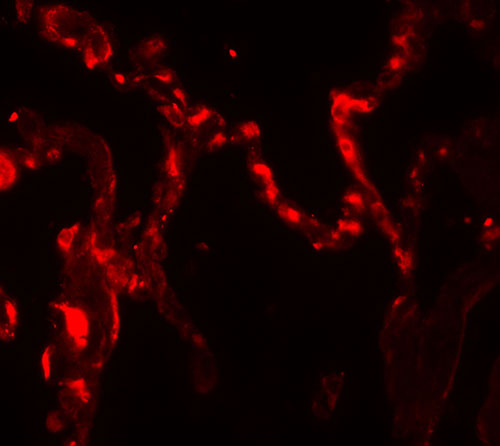IL-37 Antibody
- SPECIFICATION
- CITATIONS
- PROTOCOLS
- BACKGROUND

Application
| WB, IHC-P, IF, E |
|---|---|
| Primary Accession | Q9NZH6 |
| Other Accession | NP_055254, 20127524 |
| Reactivity | Human |
| Host | Rabbit |
| Clonality | Polyclonal |
| Isotype | IgG |
| Calculated MW | Predicted: 24 kDa Observed: 23kDa |
| Application Notes | IL-37 antibody can be used for detection of IL-37 by Western blot at 1 - 2 µg/ml. |
| Gene ID | 27178 |
|---|---|
| Target/Specificity | IL37; IL-37 antibody is human specific. Multiple isoforms of IL-37 are known to exist; this antibody will only detect the largest isoform. IL-37 antibody is predicted to not cross-react with IL-36. |
| Reconstitution & Storage | IL-37 antibody can be stored at 4℃ for three months and -20℃, stable for up to one year. |
| Precautions | IL-37 Antibody is for research use only and not for use in diagnostic or therapeutic procedures. |
| Name | IL37 (HGNC:15563) |
|---|---|
| Function | Immune regulatory cytokine that acts as a suppressor of innate inflammatory and immune responses involved in curbing excessive inflammation. Signaling can occur via two mechanisms, intracellularly through nuclear translocation with SMAD3 and extracellularly after secretion and binding to its receptor composed of IL18R1 and IL18RAP. Suppresses, or reduces, pro-inflammatory cytokine production, including IL1A and IL6, as well as CCL12, CSF1, CSF2, CXCL13, IL1B, IL23A and IL1RN, but spares anti-inflammatory cytokines. Inhibits dendritic cell activation. |
| Cellular Location | Cytoplasm, cytosol. Nucleus. Secreted Note=Stimulation with IL1B leads to colocalization with SMAD3 mostly in perinuclear regions (PubMed:20935647, PubMed:33674380). Only the CASP1- cleaved mature form translocates into the nucleus upon LPS stimulation (PubMed:18390730). The secretion is dependent on protein unfolding and facilitated by the cargo receptor TMED10; it results in protein translocation from the cytoplasm into the ERGIC (endoplasmic reticulum- Golgi intermediate compartment) followed by vesicle entry and secretion (PubMed:32272059, PubMed:33674380). |
| Tissue Location | In general, low constitutive expression, if any, in healthy tissues; high expression in inflammatory counterparts, including in synovial tissues from individuals with active rheumatoid arthritis. Isoform A, isoform B and isoform C are expressed in testis, colon, placenta, lung and lymph node. Isoform D and isoform E were found only in testis and bone marrow. Whereas only isoform A is found in brain, only isoform B in kidney and only isoform C in heart |

Thousands of laboratories across the world have published research that depended on the performance of antibodies from Abcepta to advance their research. Check out links to articles that cite our products in major peer-reviewed journals, organized by research category.
info@abcepta.com, and receive a free "I Love Antibodies" mug.
Provided below are standard protocols that you may find useful for product applications.
Background
Interleukin 37 (IL-37) is a member of the interleukin 1 cytokine family (reviewed in 1). It can bind to, and may be a ligand for interleukin 18 receptor (IL18R1/IL-1Rrp). IL-37 also binds to interleukin 18 binding protein (IL18BP), an inhibitory binding protein of interleukin 18 (IL18), and subsequently forms a complex with IL18 receptor beta subunit, and through which it inhibits the activity of IL18 (1). IL-37 can also interact with Smad3 and expression of IL-37 in macrophages or epithelial cells resulted in near complete suppression of pro-inflammatory cytokines, suggesting that IL-37 may act as a natural suppressor of the innate inflammatory and immune responses (2,3).
References
Boraschi D, Lucchesi D, Hainzl S, et al. IL-37: a new anti-inflammatory cytokine of the IL-1 family. Eur. Cytokine Netw. 2011; 22:127-47.
Nold MF, Nold-Petry CA, Zepp JA, et al. Interleukin 37 is a fundamental inhibitor of innate immunity. Nat. Immunol. 2010; 11:1014-22.
Sakai N, Van Sweringen HL, Belizaire RM, et al. Interleukin-37 reduces liver inflammatory injury via effects on hepatocytes and non-parenchymal cells. J. Gastroenterol. Hepatol. 2012; 27:1609-16.
If you have used an Abcepta product and would like to share how it has performed, please click on the "Submit Review" button and provide the requested information. Our staff will examine and post your review and contact you if needed.
If you have any additional inquiries please email technical services at tech@abcepta.com.













 Foundational characteristics of cancer include proliferation, angiogenesis, migration, evasion of apoptosis, and cellular immortality. Find key markers for these cellular processes and antibodies to detect them.
Foundational characteristics of cancer include proliferation, angiogenesis, migration, evasion of apoptosis, and cellular immortality. Find key markers for these cellular processes and antibodies to detect them. The SUMOplot™ Analysis Program predicts and scores sumoylation sites in your protein. SUMOylation is a post-translational modification involved in various cellular processes, such as nuclear-cytosolic transport, transcriptional regulation, apoptosis, protein stability, response to stress, and progression through the cell cycle.
The SUMOplot™ Analysis Program predicts and scores sumoylation sites in your protein. SUMOylation is a post-translational modification involved in various cellular processes, such as nuclear-cytosolic transport, transcriptional regulation, apoptosis, protein stability, response to stress, and progression through the cell cycle. The Autophagy Receptor Motif Plotter predicts and scores autophagy receptor binding sites in your protein. Identifying proteins connected to this pathway is critical to understanding the role of autophagy in physiological as well as pathological processes such as development, differentiation, neurodegenerative diseases, stress, infection, and cancer.
The Autophagy Receptor Motif Plotter predicts and scores autophagy receptor binding sites in your protein. Identifying proteins connected to this pathway is critical to understanding the role of autophagy in physiological as well as pathological processes such as development, differentiation, neurodegenerative diseases, stress, infection, and cancer.




